Bridge Girder-End Displacement Reconstruction Using a Novel Hybrid Attention Mechanism Leveraging Multisource Information
Abstract
In the realm of structural health monitoring (SHM) of bridge structures, the accurate reconstruction of girder-end displacement (GED) is crucial for identifying potential structural damage and ensuring the monitoring system’s reliability. A novel fine-grained spatial (FGS) attention mechanism, combined with efficient channel attention (ECA), has been proposed to effectively utilize multisource monitoring data. This hybrid attention mechanism has been integrated into an arithmetic optimization algorithm–bidirectional long short-term memory (AOA–BiLSTM) framework for reconstructing GED using non-GED data, including deflection, temperature, strain, and traffic data. Data are organized into a two-dimensional array based on sensor types and spatial locations to capture interchannel and intrachannel correlations. ECA captures local correlations among different sensor types, while the proposed FGS enhances model interpretability by focusing on local dependencies within each sensor type. Huber loss is employed for robust performance, and AOA techniques are used for efficient hyperparameter optimization. Validation with real-world data from a cable-stayed bridge demonstrates the necessity and efficacy of considering multidimensional information correlations in response reconstruction for SHM applications. This work lays a theoretical foundation for improving safety assessments, anomaly detection, data recovery, and virtual sensing in bridge structures.
1. Introduction
With the rapid development of modern transportation infrastructure and the gradual aging of bridges constructed in earlier periods, growing attention has been drawn to the safety concerns related to in-service bridges [1–3]. The catastrophic human casualties and substantial economic losses associated with bridge collapse incidents have underscored the critical need for ensuring the operational safety of bridges [4–6]. As a result, structural health monitoring (SHM) systems have been widely implemented to safeguard this essential infrastructure [7–11]. However, due to a range of potential factors such as sensor aging, malfunctions, or random interference, SHM systems inevitably encounter data loss or anomalies (such as bias, outliers, drifting, or noise) in daily operations, consequently hindering the assessment of the structure’s health condition [12]. Therefore, accurate reconstruction of structural responses is of significant importance in the case of sensor or monitoring system faults. It can provide a consistent reference framework for assessing the bridge’s performance and recovering missing data, thereby ensuring the monitoring system’s continuity [13]. Regarding static responses, previous studies have shown that girder-end displacement (GED) monitoring data can illustrate how structures respond to environmental factors and traffic loads, making them one of the most crucial indicators of safety performance [14]. Therefore, the emphasis of this study lies in the real-time reconstruction of GED monitoring data using other types of information.
Structural response reconstruction methods mainly encompass two categories: model-based approaches and data-driven methods. Model-based techniques generally necessitate an understanding of structural characteristics, emphasizing the relationship between external forces and structural deformations [15, 16]. For example, Zhang et al. [17] introduced a method that combines the inverse finite element method (FEM) formulation with the strain-gradient theory to create a nonlinear shape-sensing model for the Euler–Bernoulli beam. In this approach, nonuniform rational B-spline basis functions serve as shape functions to reconstruct the displacements. Although some methods have achieved satisfactory reconstruction results, they largely depend on the accuracy of the FEM [18–21]. These approaches improve prediction accuracy by taking into account material wear and the development process of structural damage. Nonetheless, obstacles and uncertainties arise from the complex mechanisms ruling bridge structural systems, including simplified concrete constitutive theories, unclear degradation processes, and performance disparities among various bridge designs, resulting in application limitations across different bridges [22].
Bridge responses are influenced by multiple factors, including material properties, external loads, weather conditions, and structural aging. It is notably challenging to model the intricate relations among these factors accurately based on physics and mechanics theory alone. Although the influence of these factors on structural responses is not well understood now, the complex mapping relationships between different structural responses can be learned and captured through data-driven approaches [23]. In the SHM system of bridges, there exists not only a degree of association among different types of sensors but also significant spatial correlation among sensor locations. Therefore, the correlation and complementarity among these sensors are expected to improve the performance of response reconstruction, anomaly detection, or virtual sensing by fully leveraging the value of mutual information among multitype sensors, which is possible, to reduce the need for costly or challenging physical measurements [24]. In recent years, this type of model has gained increasing attention to promote the development of SHM. For example, Zhang et al. [25] proposed a multivariate Bayesian dynamic regression method for reconstructing missing SHM data, demonstrating good computational efficiency and accuracy. Principal component analysis and probabilistic principal component analysis have also been employed to extract time-related correlations from various dimensions for the reconstruction of missing data [26]. Additionally, compressed sensing techniques [27, 28] and sparse representation of low-rank data [29] have been successfully applied to the reconstruction of randomly missing acceleration and velocity signals. However, for more complex, large-scale, long-term continuous response reconstruction, traditional data-driven methods may face limitations and performance degradation.
In recent years, deep learning has attracted widespread attention from researchers in the SHM field. Thanks to the powerful nonlinear approximation ability and model generalization performance of deep neural networks, capturing the complex mapping relationships between multitype structural responses has become possible. Jeong et al. [30] proposed a data-driven bidirectional recurrent neural network for sensor data reconstruction, taking into account the spatiotemporal correlations between measured data. Lei et al. [31] proposed a deep convolutional generative adversarial network to reconstruct lost data, utilizing a generator to extract features and reconstruct signals, and a discriminator to improve accuracy. Lu et al. [32] proposed a method for reconstructing structural acceleration responses based on a bidirectional long short-term memory (BiLSTM) network, which explores the complex spatiotemporal correlations between measured data. Wang et al. [33] established a regression model based on long short-term memory (LSTM) to explore the relationship between environmental temperature and the thermally induced low-frequency components in the GED and achieved a reconstruction accuracy for the missing GED data within 10%. Chen [34] proposed a deep learning and autoregressive model with an attention mechanism framework, where a soft attention layer is integrated into the framework following the bidirectional gated recurrent unit layers, serving to eliminate redundant information from multiple sensors. Their results indicate that the response reconstruction performance of the proposed framework surpasses the one-dimensional convolutional neural networks (1D-CNNs) and the hybrid deep learning and autoregressive models.
The aforementioned studies mainly focus on reconstructing structural responses using other types of structural responses, which inevitably neglect the influence of environmental and operational conditions, e.g., temperature and traffic loading. It has been reported that fusing multisource data offers a more comprehensive and effective information base for reconstruction tasks [35]. Taking into account the feature correlation across different types of sensors (e.g., temperature and displacement) as well as the spatial correlation among sensor locations is expected to enhance response reconstruction accuracy [36]. Existing structural response reconstruction techniques predominantly rely on the same type of sensors and often neglect the relationships between different types of sensors. Notably, there is limited research that considers the interdependencies among different types of sensors. For instance, data fusion methods based on LSTM have been employed to reconstruct bridge structures’ deformations using strain and acceleration data [37, 38], without accounting for the intricate correlations between structural responses and environmental conditions. In current practices, data from diverse sensor types, such as GED, deflection, temperature, or strain, are typically integrated as input with only channel attention mechanisms employed to capture dependencies among them [39]. However, this approach has two primary shortcomings. First, it results in a homogenized weighting strategy across all sensor types, thereby neglecting the spatial correlations within each type of sensor. Secondly, conventional attention mechanisms necessitate pooling operations across different dimensions, which merge data from various sensor types, thereby diminishing the model’s sensitivity toward specific physical phenomena. Additionally, hyperparameter selection in deep learning models poses a challenge and current methodologies largely depend on empirical manual settings, which can compromise the accuracy of response reconstruction [40–43]. This issue becomes especially pronounced for SHM of bridges where one-dimensional time series data are measured from each sensor, making it difficult to apply spatial attention mechanisms that are popular in other domains.
To address the aforementioned challenges, this paper introduces a novel fine-grained spatial (FGS) attention mechanism combined with efficient channel attention (ECA) to enhance deep learning’s ability to analyze physical measurements from bridges. This study focuses on reconstructing bridge GED using multisource data such as deflection, temperature, strain, and traffic information. One of the key contributions of this paper is the formulation of input data into two-dimensional arrays based on sensor type and spatial location, enabling the model to capture both sensor type and temporal correlations concurrently. The ECA–FGS attention mechanism is employed to enhance these correlations. The ECA component captures the interrelations among different types of local sensors, while the FGS mechanism prevents the mixing of different physical quantities and enhances model interpretability by focusing specifically on the spatial correlations of each sensor type. To further enhance the model’s robustness against outliers, the Huber loss function is utilized, and the arithmetic optimization algorithm (AOA) is employed for optimizing hyperparameters related to Huber loss and hidden units in the BiLSTM architecture.
2. Methodology
In this study, a BiLSTM [44] is employed for GED reconstruction using non-GED data. The BiLSTM, composed of two LSTM networks, processes input sequences in both forward (start to end) and backward (end to start) directions, integrating past-to-future and future-to-past information flows. To optimize multisource data integration in bridge monitoring, we developed a novel attention mechanism for the BiLSTM, enabling the capture of multilevel information weights.
2.1. BiLSTM Network
2.2. ECA–FGS Attention Mechanism
Attention mechanisms enable a model to focus selectively on essential features, assigning varying levels of importance to different components [47]. This is crucial for our task, where the input for each time step is structured as a matrix of dimension C × S, where C represents the number of channels (in this study, the same type of sensors are grouped into one channel) and S denotes the number of sensors in each channel. Please note that the number of sensors for each channel has to be the same due to the matrix structure of the input. Given the dual-dimensional nature of the input (channel and spatial), a specialized attention mechanism is designed to capture both interchannel and intrachannel (spatial) correlations to improve response reconstruction (see Figure 1).
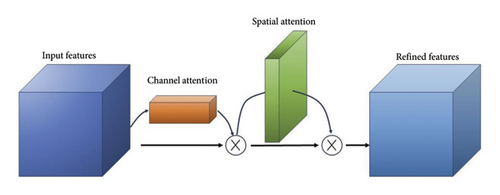
2.2.1. ECA Mechanism
While the convolutional block attention module (CBAM) [48] commonly used in computer vision effectively combines channel and spatial attention, it is less suited for monitoring physical quantities in bridges. CBAM’s reliance on global average and max pooling to extract global statistical characteristics can introduce noise and redundant information into SHM time series data, particularly when the channel scale is small, potentially leading to overfitting. Additionally, while CBAM excels at capturing broad channel dependencies, it struggles with the local dependencies crucial for monitoring bridge data. In contrast, the ECA mechanism, which utilizes 1D convolution along the channel axis [49], aligns more closely with the intrinsic characteristics of bridge data. Figure 2 illustrates the architecture of the employed ECA integrated into the BiLSTM network in this paper.
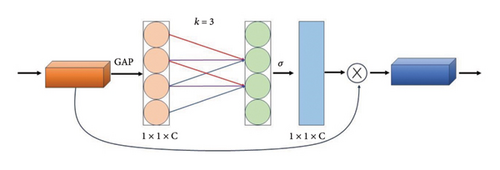
2.2.2. The Proposed FGS Attention Mechanism
In this way, the ECA–FGS module offers dual advantages: It bolsters the model’s interpretability by preventing the information mixture of different sensor types and enhances performance by effectively capturing local spatial dependencies. Figure 3 shows the structure of the FGS attention mechanism. Given that the spatial dimension of the sensors S = 4 in this paper, the value of n = 2 is derived based on the proposed equation (14), corresponding to the 1D convolution kernel size in Figure 3. The kernel size n impacts the model’s feature extraction: Larger n values capture broader patterns, while smaller ones focus on local details. A careful balance is needed, as large kernels may overlook fine details but aid generalization, whereas small kernels might overfit. Typically, the choice of kernel size is informed by empirical evidence and best practices, which is the purpose of equation (14) to balance granularity with generalization.
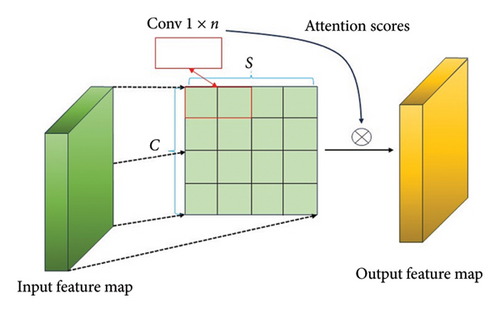
2.3. Huber Loss Function
The proposed AOA–BiLSTM and ECA–FGS network is trained using the Adam optimizer, with a maximum of 30 epochs and an initial learning rate of 0.01. A piecewise schedule is employed to reduce the learning rate by 0.1 every 20 epochs. Table 1 details the AOA–BiLSTM and ECA–FGS model architecture, whose framework is shown in Figure 4. The proposed framework integrates several key components to enhance the accuracy of the reconstructed GED. BiLSTM serves as the core sequential model, while AOA optimizes its hyperparameters to ensure the model’s performance. ECA is employed to capture local channel-wise dependencies between different types of sensor data (e.g., temperature, strain, and deflection), while the proposed FGS attention mechanism focuses on refining spatial correlations within each sensor type.
| Block | Layer | Number/size/stride of kernels or number of neurons |
|---|---|---|
| Input | Sequence input layer | Size: [4, 4] |
| Preprocessing | Sequence folding layer | — |
| ReLU layer | — | |
| ECA attention | Average pooling layer | Size: [1, 4] for the dimension S |
| Convolutional layer | 1 kernel of size [3, 1] with padding | |
| Sigmoid layer | — | |
| Multiplication layer | — | |
| FGS attention | Convolutional layer | 1 kernel of size [1, 2] with padding |
| Sigmoid layer | — | |
| Multiplication layer | — | |
| Sequence learning | Sequence unfolding layer | — |
| Flatten layer | ||
| BiLSTM layer | Neurons number determined using AOA | |
| Reconstruction | Huber loss layer | Hyperparameter δ determined using AOA |

3. Hyperparameter Optimization and Reconstruction Error Metrics
In the presented model, two pivotal hyperparameters are present which need careful tuning: the number of hidden units u in the BiLSTM and the transition point δ in the Huber loss function. Hyperparameter optimization, a complex nonconvex problem, challenges traditional methods like grid search due to their computational intensity and exhaustive nature, making them impractical for large datasets. Random search and gradient-based methods often fail to find optimal parameters or get trapped in local minima. Similarly, genetic algorithms and particle swarm optimization are slow and prone to suboptimal outcomes. Therefore, this paper utilizes the AOA, whose distinctive exploration and exploitation mechanisms have proven to yield superior performance in nonconvex optimization problems [51].
3.1. AOA
- 1.
The candidate solution is defined as
() -
where n represents the number of initial solutions which is set to 20 in this study and m denotes the number of hyperparameters. Here, m = 2, indicating that there are two hyperparameters to optimize, i.e., the number of hidden units u and the transition point δ.
- 2.
After the initialization step, the math optimizer accelerated (MOA) is computed for exploration purposes, which is derived from
() -
where Citer represents the current iteration and Citer ∈ (1, Miter). Max and Min indicate the maximum and minimum values of the acceleration function, respectively. MOA(Citer) denotes the function value during the tth iteration, which is calculated using the following equation:
() -
where Citer signifies the current iteration, yi,j(Citer + 1) denotes the jth position of the ith solution in the subsequent iteration, and best(yj) is the jth position in the optimal iteration. ε is a small integer number used to prevent division by zero, while ubj and lbj, respectively, represent the upper and lower bounds of the jth position. r2 is a random number in the range of [0,1], and μ is set to 0.5 in this study based on the recommendation [51]. MOP(Citer) denotes the function value of the math optimizer probability (MOP), which is defined as
() -
where Miter stands for the maximum iterations and α is a sensitive parameter defining the precision of the exploitation process during iterations. In this study, α is set to 5.
- 3.
Exploitation:
() -
To maintain equilibrium between exploration and exploitation, a random number, r3, in the range of [0,1] is used as a transition criterion. When r3 > MOA, the candidate solution attempts to diverge from the approximate optimal solution, signifying the algorithm is in the exploration phase. Otherwise, it shifts to exploitation, focusing on refining the solutions in the neighborhood of the current best solution. In this paper, the search space for hyperparameters is set as u ∈ [1, 30] for the number of hidden units and δ ∈ [0.01, 1] for the Huber loss hyperparameter.
3.2. Evaluation Metrics for Response Reconstruction
In the above equations, n represents the sample size and xt and are the monitored and reconstructed data, respectively. A lower MSE, MAE, and ARPE indicate higher reconstruction accuracy, while an R2 score closer to 1 suggests a higher fidelity in the reconstructed values to the observed data.
3.3. Visualization for Reconstruction Error
To offer an intuitive representation of the reconstruction precision, we employ visualization techniques, specifically the error bar plot. The error ei at each time instant denotes the misfit between measured and reconstructed values. Given that the original dataset consists of 2000 data points, a windowing approach is employed to obtain a smooth and stable representation of the errors over time. The errors are divided into nonoverlapping windows with a constant length of 100. Then, within each window, the sample mean and sample standard deviation of the errors are computed. The error bars represent one standard deviation from the mean error within each window. The length of the error bars signifies the level of uncertainty or variability in the errors for that particular window and method.
4. Application to an Existing Bridge
4.1. Overview of the Bridge
Located in downtown Ningbo, China, the Ningbo Bund Bridge is an asymmetrical cable-stayed structure with a single tower and four cable planes. It features a main span of 225 m and two side spans of 82 and 30 m, totaling 337 m in length. The main girder consists of separate steel box girders connected by transverse girders (for further details, see reference [52]). The Bund Bridge is shown in Figure 5.

The comprehensive SHM system of the Bund Bridge includes various sensors to monitor key structural and environmental parameters. These sensors measure GED, girder deflection, strain, vehicle weight, and temperature. GED is measured using resistive displacement sensors with an accuracy of 0.01 mm, mounted on embedded steel plates at the side piers (Figure 6(a)). Girder deflections are also recorded by resistive displacement sensors positioned along the main span with a 1-Hz sampling frequency (Figure 6(b)). Environmental temperature is measured with sensors RH1–RH3 (Figure 6(c)); structural temperatures are monitored with SGT1–SGT16 on the girder (Figure 6(d)) and SGT17–SGT24 on the tower (Figure 6(e)). Strain is monitored by resistive strain gauges with an accuracy of 0.25%, installed at the girder-tower connection (STR1–STR16, Figures 6(f) and 6(g)). Vehicle weights are measured by a weigh-in-motion (WIM) system located at the bridge entrance (Figure 6(h)).
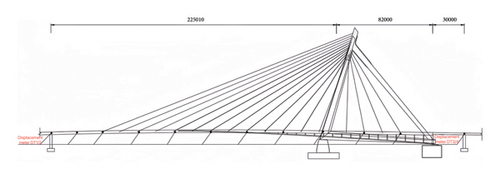
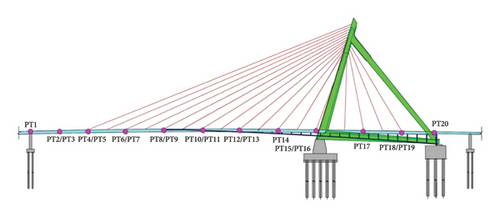
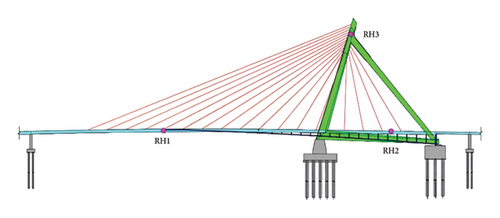
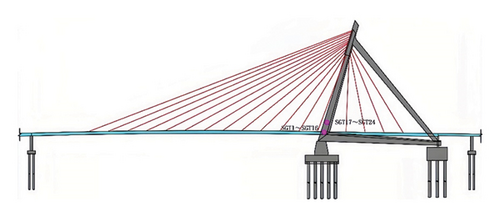
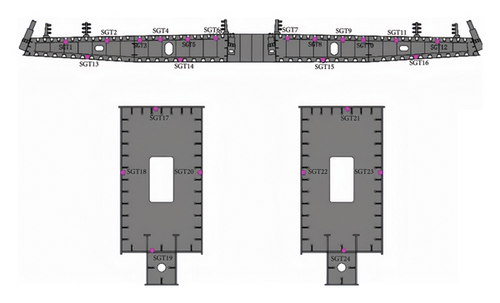
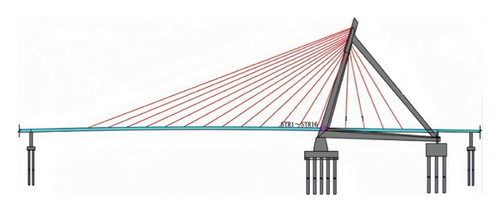

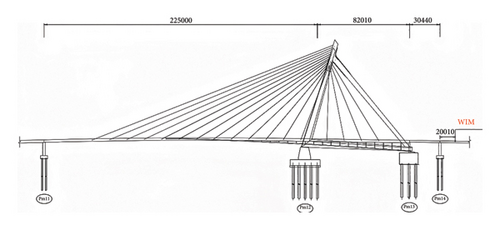
To ensure accurate reconstruction of GED and consider the effects of temperature, vehicle weight, strain, and deflection, these measured data are integrated into the AOA–BiLSTM model with ECA–FGS attention mechanisms.
4.2. Data Preparation
As raw measurement data are disturbed by many transient and irrelevant factors, the measured GED data are averaged at every 5-min window to reduce noise and obtain smoother GED value. Similarly, the input data for reconstruction, including strain, temperature, and girder deflection, are also averaged at every 5-min window. The length of 5-min window used in this study allows for smoothing the raw measurements to remove random fluctuations, meanwhile still possessing the short-term variations of measured information. As for the traffic weights measured by WIM, 4 different traffic metrics are defined to provide a comprehensive profile of traffic load on the bridge within every 5-min window, i.e., cumulative vehicle weights in every 5-min window, average vehicle weights, median vehicle weights, and traffic volume (number of vehicles).
The 5-min average GED data from April 18, 2020, to May 14, 2020, are used as the target output in this study, including the GED sensors DT2, DT3, and DT4. Following the proposed framework, a 2D input structure is constructed whose rows correspond to types of sensors and columns correspond to specific sensors within each type. Given that four types/channels of data are considered (deflection, temperature, strain, and traffic information), the channel dimension is set to four. To encapsulate a wide range of features within each channel, 4 sensors/metrics are selected for each channel. For deflection data, inputs are PT1, PT6, PT13, and PT15 (Figure 7(a)). Deflections vary across these locations due to differences in structural position, load distribution, and support conditions. For temperature data, the selected sensors are RH1, RH2, RH3 (ambient), and SGT14 (structural) (Figure 7(b)). Ambient sensors show similar readings, while SGT14 exhibits higher variability due to thermal responses in the structure. For strain data, inputs include STR4, STR7, STR9, and STR14 (Figure 7(c)). Strain differences arise from localized stress variations due to bending moments and axial forces at different points. The traffic data comprise cumulative weight, average weight, median weight, and traffic volume (Figure 8). Variations in these metrics reflect nonuniform traffic patterns and vehicle types. Despite the differences in these measurements, they exhibit correlations due to the interconnected nature of the structural behavior under various loads. For instance, deflection and strain are both influenced by vehicle load and traffic volume, and temperature fluctuations can impact strain and deflection through material thermal expansion and contraction.
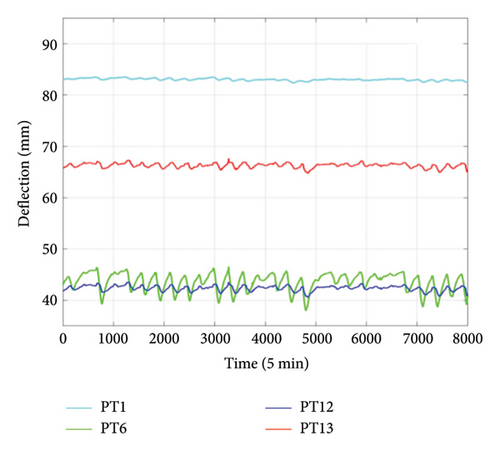
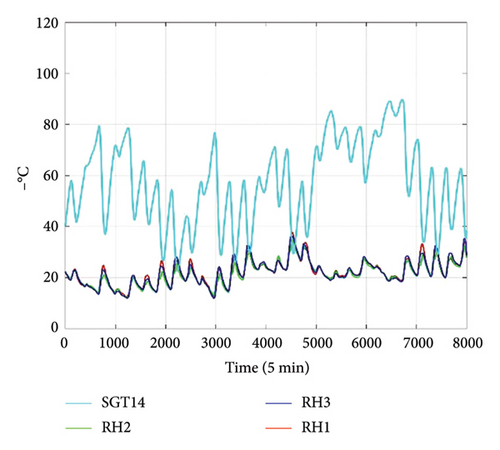
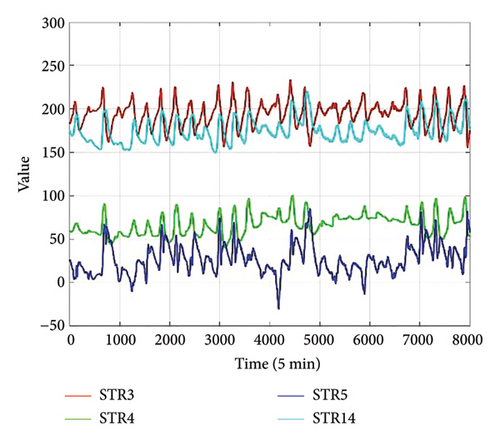
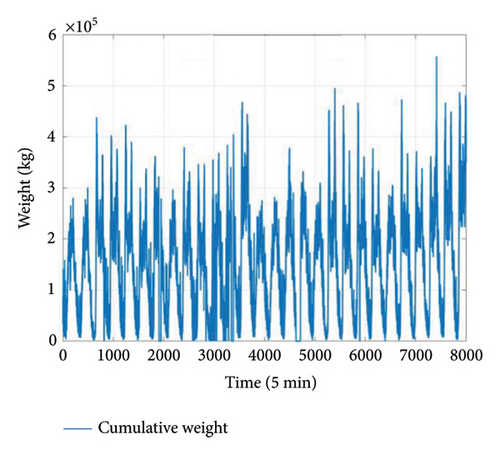
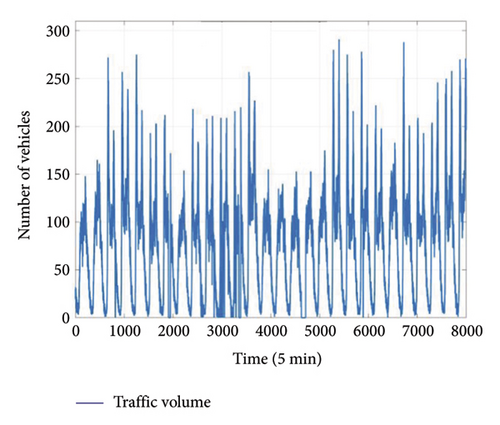
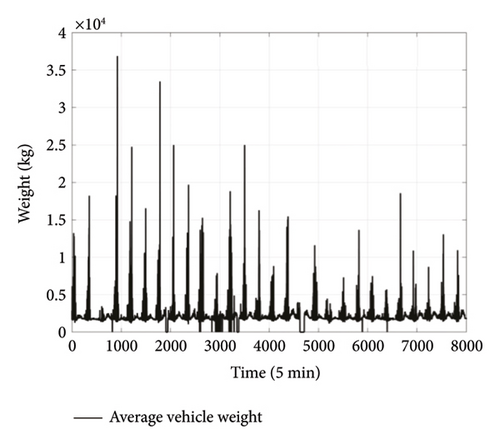
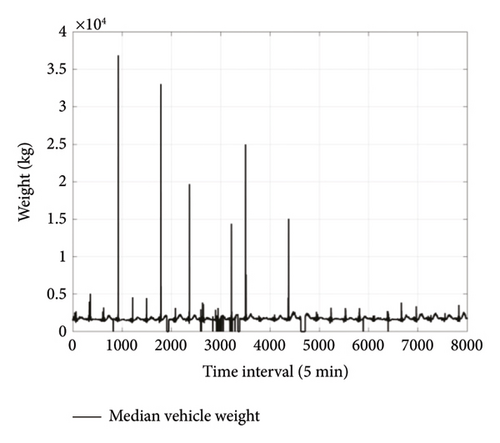
For the target GED data, we consider the first 6000 data points as known information for model training, while the subsequent 2000 data points are utilized to validate the reconstruction performance of the model, as shown in Figure 9. Specifically, a 3D total input with a size of [4, 4, 6000] is utilized for learning the target deflection data.
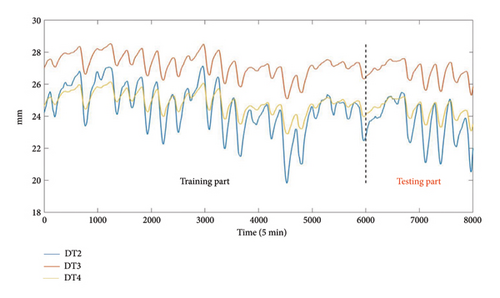
4.3. Reconstruction Results Based on AOA–BiLSTM and ECA–FGS
The optimization of the number of hidden units in BiLSTM and the hyperparameter of the Huber loss function is performed using the AOA method presented in Section 3. The optimization results, as shown in Figure 10, indicate rapid convergence after five iterations. The optimized hyperparameter combinations (u, δ) at locations DT2, DT3, and DT4 are (16, 0.05), (21, 0.04), and (18, 0.07), respectively. Then, the proposed AOA–BiLSTM integrated with ECA–FGS attention is trained using the previously discussed input and target data. The GED reconstruction results are illustrated in Figures 11(a), 11(b), and 11(c), corresponding to the sensors DT2, DT3, and DT4, respectively. A good agreement between the reconstructed and the actual responses can be observed, despite some discrepancies existing, especially at the peaks and valleys for DT4. The RMSE, MAE, ARPE, and R2 are reported in Tables 2, 3, and 4 for DT2, DT3, and DT4, respectively. All error metrics are relatively small, with an R2 very close to 1, indicating excellent reconstruction performance.
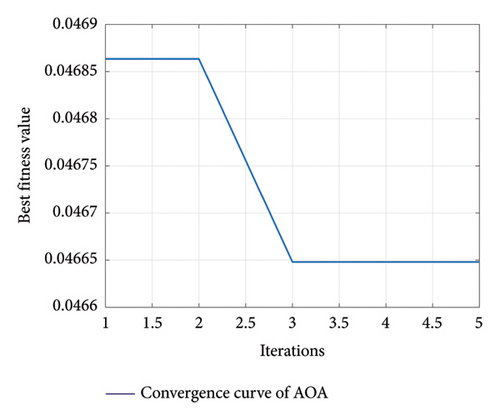
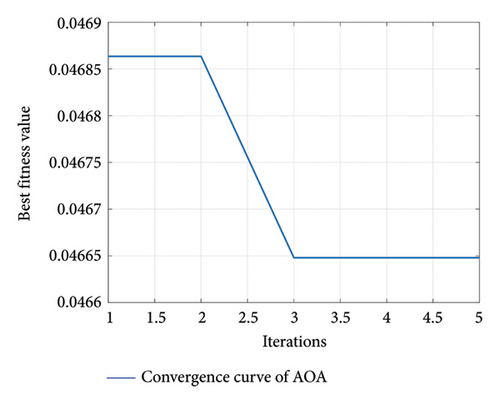
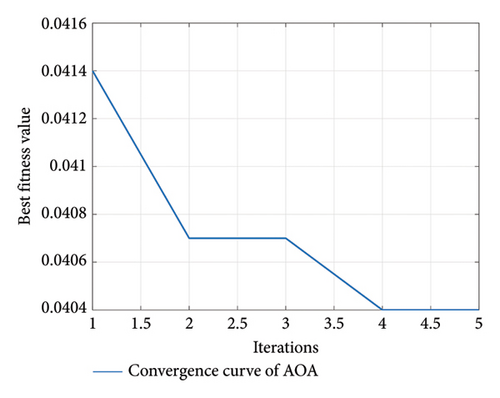
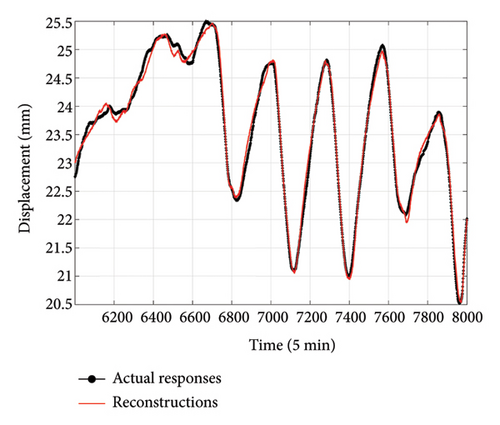
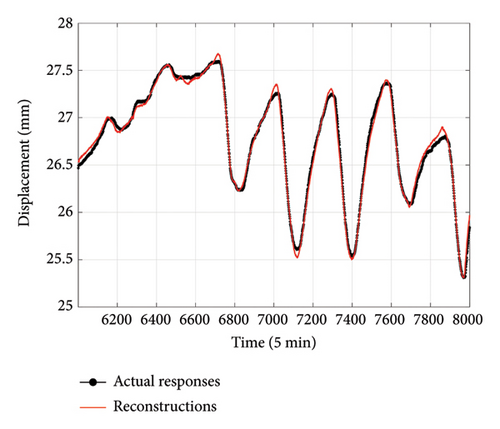
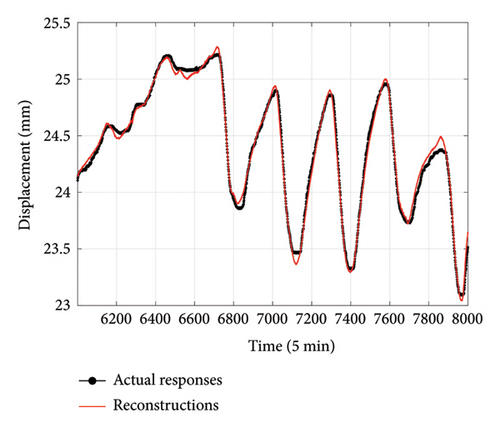
| Methods | Proposed | GPR | SVR | BiLSTM | BiLSTM-SE | BiLSTM-CBAM | MLR |
|---|---|---|---|---|---|---|---|
| RMSE | 0.1088 | 0.3458 | 0.6103 | 0.1652 | 0.1558 | 0.1673 | 0.1542 |
| MAE | 0.0884 | 0.2564 | 0.3510 | 0.1331 | 0.1253 | 0.1392 | 0.1247 |
| ARPE | 0.3751 | 1.0992 | 1.5699 | 0.5621 | 0.5324 | 0.5941 | 0.5336 |
| R2 | 0.9923 | 0.9222 | 0.7575 | 0.9822 | 0.9842 | 0.9818 | 0.9838 |
| Methods | Proposed | GPR | SVR | BiLSTM | BiLSTM-SE | BiLSTM-CBAM | MLR |
|---|---|---|---|---|---|---|---|
| RMSE | 0.0443 | 0.1434 | 0.3553 | 0.0551 | 0.0527 | 0.0816 | 0.0512 |
| MAE | 0.0348 | 0.1063 | 0.2056 | 0.0437 | 0.0415 | 0.0690 | 0.0394 |
| ARPE | 0.1303 | 0.4029 | 0.7852 | 0.1636 | 0.1552 | 0.2578 | 0.1463 |
| R2 | 0.9939 | 0.9370 | 0.6132 | 0.9907 | 0.9915 | 0.9796 | 0.9910 |
| Methods | Proposed | GPR | SVR | BiLSTM | BiLSTM-SE | BiLSTM-CBAM | MLR |
|---|---|---|---|---|---|---|---|
| RMSE | 0.0457 | 0.1463 | 0.2997 | 0.0543 | 0.0514 | 0.0576 | 0.0553 |
| MAE | 0.0374 | 0.1170 | 0.1747 | 0.0431 | 0.0411 | 0.0460 | 0.0462 |
| ARPE | 0.1538 | 0.4834 | 0.7313 | 0.1769 | 0.1692 | 0.1893 | 0.1839 |
| R2 | 0.9930 | 0.9280 | 0.6981 | 0.9901 | 0.9911 | 0.9888 | 0.9873 |
4.4. Comparison With Other Methods
To rigorously evaluate the reconstruction performance of the proposed method, a comparative analysis is conducted to compare the reconstruction results of GED obtained through the proposed model with those derived from Gaussian process regression (GPR) [53], support vector regression (SVR) [54], standard BiLSTM [44] approaches, BiLSTM approaches with squeeze-and-excitation attention mechanism (BiLSTM-SE) [55] for channel attention, and BiLSTM variants that employ CBAM (BiLSTM-CBAM) [48] for channel and spatial attention. Additionally, multiple linear regression (MLR) is included as a baseline, with its fixed-weight characteristic used to validate the effectiveness of the attention mechanism’s dynamic, data-driven weighting, which adapts based on input features in a deep learning framework. The reconstruction outcomes for the six approaches are illustrated in Figures 12(a), 12(b), and 12(c), corresponding to sensors DT2, DT3, and DT4, respectively. It can be observed that the proposed method demonstrates clear advantages in both peak regions and overall alignment. The precision metrics presented in Tables 2, 3, and 4, including MSE, MAE, RPE, and R2, further confirm this conclusion, as the proposed method consistently achieves the highest accuracy across all three datasets. Notably, the BiLSTM-CBAM method performs the worst among the BiLSTM-based approaches, likely due to the CBAM confusing different types of monitoring variables. Similarly, MLR performs worse than the proposed method, as its fixed-weight nature limits its ability to capture the complex, dynamic relationships between the input features and the target variable.
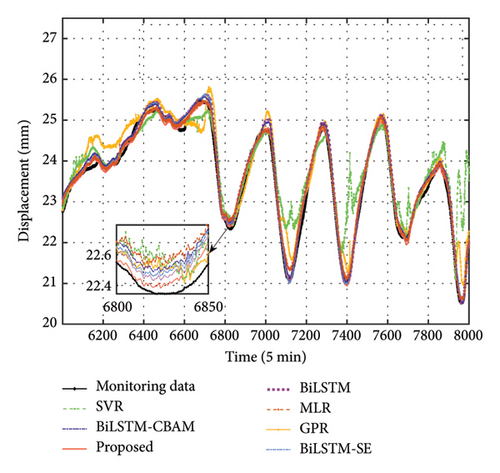
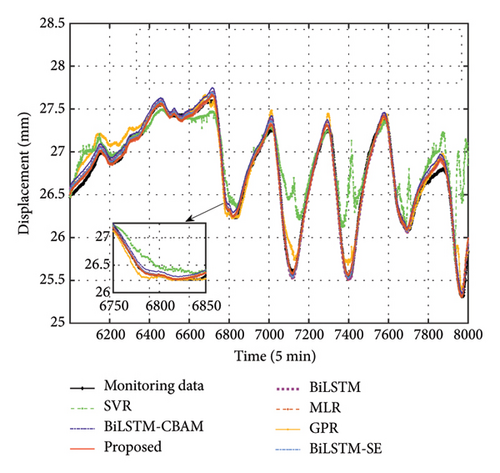
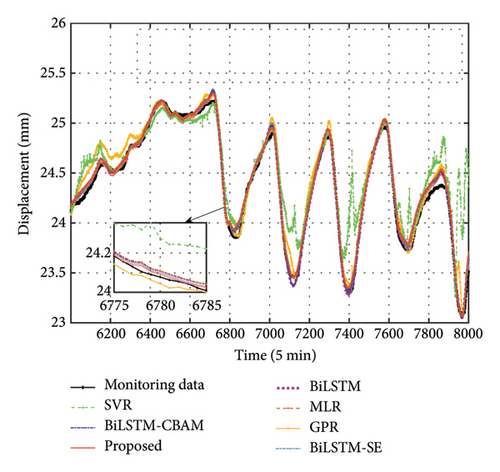
To further quantify the advantages, we compared the MAE, showing that our method improves by an average of 66.94% over GPR, 78.83% over SVR, 22.39% over BiLSTM, 18.20% over BiLSTM-SE, 34.92% over BiLSTM-CBAM, and 19.94% over MLR across three datasets. In anomaly detection, larger reconstruction errors may indicate potential structural anomalies. The robustness and precision of the proposed method provide a clear advantage, making it especially well-suited for identifying such anomalies with greater accuracy and reliability. Subsequently, employing the visualization techniques outlined in Section 3.2, we generate error bars for each of the five different approaches. These results are illustrated in Figures 13(a), 13(b), and 13(c). For this analysis, we adopt a window size w = 100, meaning that the mean and standard deviation of the error are calculated over each set of 100 data points. Upon reviewing the figures, it is clear that our proposed method yields an error closest to zero mean and exhibits the lowest standard deviation, as indicated by the narrow error bars, underscoring its superior stability compared to other methods.
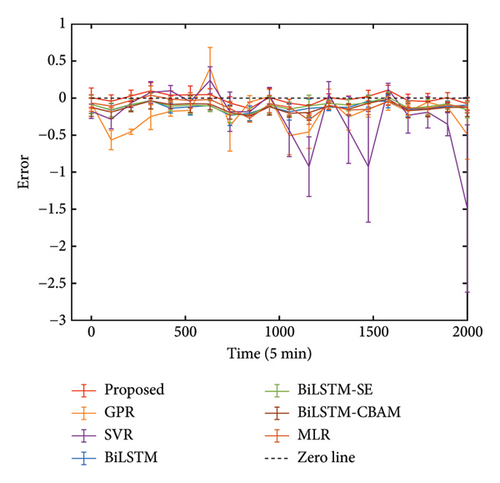
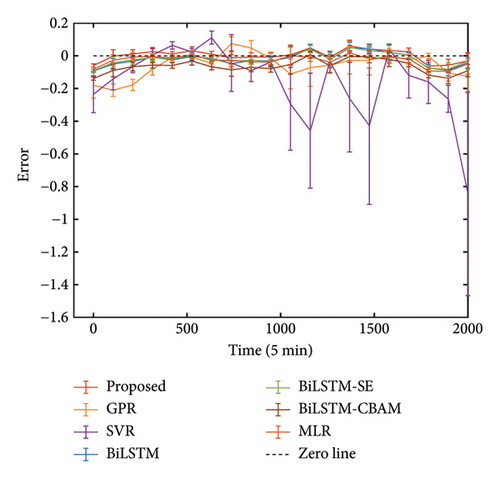
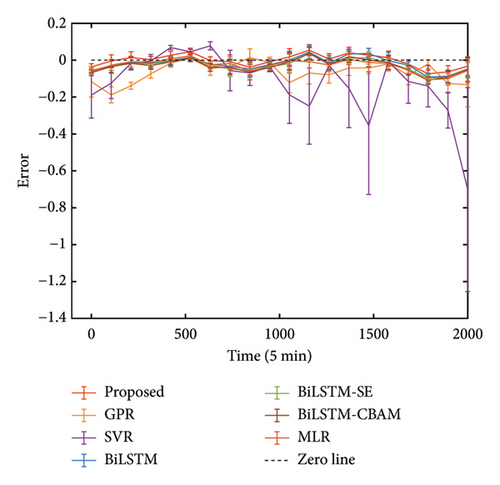
4.5. Anomaly Detection Simulation
In addition to directly reconstructing missing data for data recovery, the proposed method can also be employed for anomaly detection. To demonstrate the anomaly detection capability of the proposed method, a simulation experiment based on DT2 data is conducted. An increasing linear trend is superposed on the original DT2 data within the time range of [1800 2000], as depicted in Figure 14. This simulation represents a scenario where local damage, particularly cracks near the supports, reduces local stiffness and primarily affects the GED [56, 57], while other inputs, such as temperature, deflection, traffic information, and longitudinal stress at mid-span, remain unchanged. This local damage minimally impacts overall deflection but significantly alters the GED. In actual cable-stayed bridges, the correlation between deflection and GED is often weak, as deflection and strain in the main girder are mainly influenced by vertical loads, while end displacement is more sensitive to support conditions. However, deflection is still included as it can slightly improve GED reconstruction accuracy when combined with other monitoring data in a multisource approach. In practice, temperature shows the highest correlation with GED [58], but other inputs provide marginal improvements. Therefore, when the temperature remains stable but GED shows significant changes, anomalies can be more easily identified.
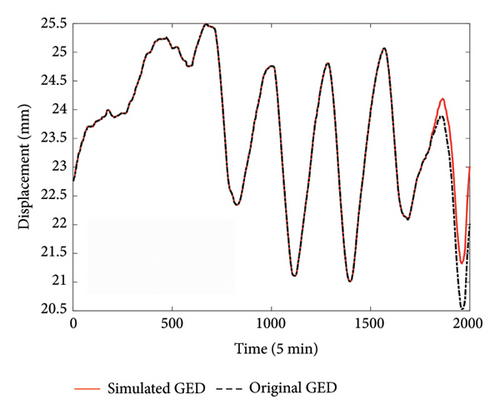
The comparison of simulated GED data and reconstructed response is shown in Figure 15(a). It is seen that a large discrepancy in the superposed increasing trend is present which reflects the potential anomaly. To provide an objective metric for anomaly detection, the error bar plot is employed here to establish the warning threshold. Since the first 1000 samples are known to be normal, their sample statistics of reconstruction errors are utilized to derive the deviation bounds of errors, which includes the following steps: (1) First evaluate the sample mean and standard deviations at each window of length 100 (i.e., 10 windows for 1000 samples); (2) compute the bounds at 10 windows based on three-sigma rule, i.e., the upper and lower values of three standard deviations of mean values; and (3) choose the maximum upper bound value among all 10 windows as the upper threshold, and similarly choose the minimum lower bound value among all 10 windows as the lower threshold. These upper and lower thresholds represent the normal range of reconstruction errors and are used to detect the abnormal state when the error exceeds them. The error bar chart is depicted in Figure 15(b). A noticeably large standard deviation at the 20th window (corresponding to the 1800th to 2000th data points given a window length of 100) is observed, whose error bar surpasses the upper threshold line, successfully detecting the simulated anomaly. Note that this section serves as a primitive study for anomaly detection and is included here for demonstration, and experimental studies on laboratory models or field structures are needed to further validate its efficacy on anomaly detection.
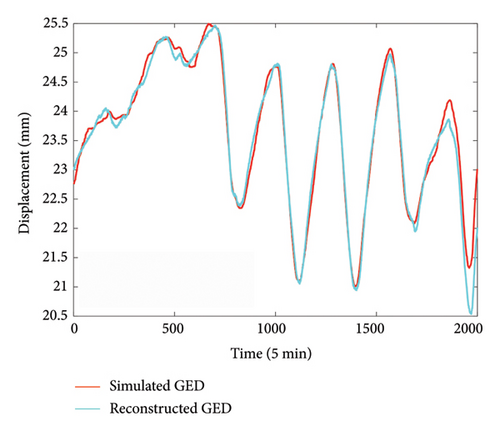
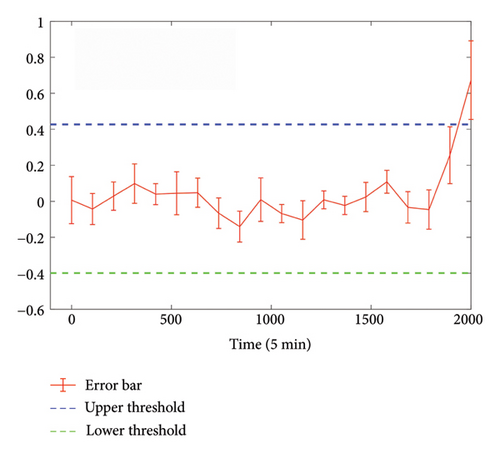
In practical applications, sensor measurement characteristics and noise may change over time. The adaptability of the proposed method to varying sensor configurations can be achieved considering the high flexibility of the proposed attention mechanism and employing regular updates of the model, for example: (1) the attention mechanism adaptively assigns lower weights to noisy data, capturing more valuable information and reducing the impact of noise; (2) the implementation of the Huber loss function within the model further enhances its robustness to noise; and (3) regular reevaluation and updates of the model ensure its alignment with the current state of the sensors. It is noteworthy that significant data drift, as illustrated in Figure 15, may indicate anomalies in the sensors or the structure. Interestingly, these features enable the use of models trained on historical monitoring data, such as data from 5 years ago, to reconstruct target responses based on current sensor readings, enabling direct estimation of the extent of GED growth under long-term influences.
5. Conclusions
In this study, we introduced an innovative deep learning framework for the reconstruction of GED from non-GED sensor data. To address the limitations of conventional methods in utilizing multisource data, we employed a two-dimensional data representation based on sensor types and spatial layouts. This structure enabled the simultaneous exploitation of intersensor-type correlations and spatial dependencies within each sensor type. A novel attention mechanism, termed FGS attention, was proposed to capture these intricate dependencies more effectively. The FGS mechanism enhances the model’s interpretability by focusing on local spatial dependencies within individual sensor types, avoiding the conflation of different physical quantities. This mechanism was combined with ECA, which focuses on local intersensor-type correlations. The hybrid attention mechanism was integrated into a BiLSTM architecture for GED reconstruction using non-GED data, including deflection, temperature, strain, and traffic data. The framework employs Huber loss for robust performance and leverages an AOA for efficient hyperparameter optimization.
Validation studies are conducted to reconstruct the measured GED data at three locations using non-GED information including girder deflection, temperature, strain, and traffic conditions from the SHM system of a cable-stayed bridge. The experimental results show that, under the same configuration parameters, our ECA–FGS-equipped AOA–BiLSTM framework significantly outperforms standard BiLSTM approaches, BiLSTM with only SE for channel attention, and BiLSTM variants that employ CBAM for channel and spatial attention. Comparative analyses with traditional machine learning methods such as GPR and SVR further confirm the robustness and superiority of our approach in handling multisource bridge data. For the cable-stayed bridge in this paper, the MAE of reconstruction results is even less than 0.1 mm. Moreover, based on the numerical study, it is possible to detect structural anomalies utilizing error bar charts of the reconstructed GED.
While the proposed method has been validated on a specific cable-stayed bridge, its data-driven nature enhances its versatility, making it suitable for other bridge types (e.g., suspension or arch bridges) and even other civil structures, provided the sensors capture relevant physical quantities. The findings underscore the necessity and effectiveness of considering sensor data correlations from multiple perspectives in the context of bridge health monitoring and response reconstruction. The theoretical contributions of our work lay a strong foundation for applications in bridge structural safety assessment, anomaly detection, data recovery, and virtual sensing.
Conflicts of Interest
The authors declare no conflicts of interest.
Funding
This work was supported by the National Natural Science Foundation of China (Grant Nos. 52208199 and 52378187), the Shanghai Science and Technology Cooperation Project of QiZhi Research Institute (Grant No. SQZ202310), and the Fundamental Research Funds for the Central Universities.
Acknowledgments
We would like to thank our funding agency for their generous support of this project. This work was supported by the National Natural Science Foundation of China (Grant Nos. 52208199 and 52378187), the Shanghai Science and Technology Cooperation Project of QiZhi Research Institute (Grant No. SQZ202310), and the Fundamental Research Funds for the Central Universities. No artificial intelligence tools were employed in the preparation of this manuscript. The authors take full responsibility for independently developing and reviewing all contents.
Open Research
Data Availability Statement
The data that support the findings of this study are available from the corresponding author upon reasonable request.




